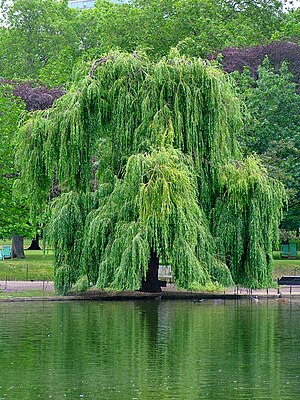Salix
| Willow | |
|---|---|
 | |
| Genus: | Salix |
| Family: | Salicaceae |
| Type: | Trees and shrubs |
| Pollination: | Insects |
The willows are deciduous trees and shrubs in the genus Salix, part of the willow family Salicaceae. There are about 350 species in this genus worldwide, found primarily on moist soils in cooler zones in the Northern Hemisphere. Some smaller species may also be known by the common names osier and sallow; the latter name is derived from the same root as the Latin salix.
Some willows, particularly arctic and alpine species, are very small; the Dwarf Willow (Salix herbacea) rarely exceeds 6 cm in height, though spreading widely across the ground.
The Weeping Willow, very widely planted as an ornamental tree, is a cultivar, Salix × sepulcralis 'Chrysocoma', derived from a hybrid between the Chinese Peking Willow and the European White Willow.
Almost all willows take root very readily from cuttings or where broken branches lie on the ground. There are a few exceptions, including the Goat Willow and Peachleaf Willow. One famous example of such growth from cuttings involves the poet Alexander Pope, who begged a twig from a parcel tied with twigs sent from Spain to Lady Suffolk. This twig was planted and thrived, and legend has it that all of England's Weeping Willows are descended from this first one[1].
Description
[edit | edit source]The leaves are deciduous, often elongate but round to oval in a few species, and with a serrated margin. Willows are deciduous with male and female flowers appearing as catkins on different plants; the catkins are produced early in the spring, often before the leaves or as the new leaves open. The fruit is a small capsule containing numerous tiny (0.1 mm) seeds embedded in white down, which assists wind dispersal of the seeds. Willows hybridize freely, and numerous hybrids are known, both naturally occurring and in cultivation.
Growing conditions
[edit | edit source]Species
[edit | edit source]Uses
[edit | edit source]The bark of the willow tree has been mentioned in ancient texts from Assyria, Sumer and Egypt as a remedy for aches and fever, and the Greek physician Hippocrates wrote about its medicinal properties in the 5th century BC. Native Americans across the American continent relied on it as a staple of their medical treatments.
The active extract of the bark, called salicin, was isolated to its crystalline form in 1828 by Henri Leroux, a French pharmacist, and Raffaele Piria, an Italian chemist, who then succeeded in separating out the acid in its pure state. Salicin is acidic when in a saturated solution in water (pH = 2.4), and is called salicylic acid for that reason.
In 1897 Felix Hoffmann created a synthetically altered version of salicin (in his case derived from the Spiraea plant), which caused less digestive upset than pure salicylic acid. The new drug, formally Acetylsalicylic acid, was named aspirin by Hoffmann's employer Bayer AG. This gave rise to the hugely important class of drugs known as non-steroidal anti-inflammatory drugs (NSAIDs).
- Other uses
|
|
Maintenance
[edit | edit source]A number of willow species were widely planted in Australia in the past, notably as erosion control measures along watercourses. They are now regarded as an invasive weed and many catchment management authorities are removing them to be replaced with native trees [2] [3].
Propagation
[edit | edit source]Harvesting
[edit | edit source]Pests and diseases
[edit | edit source]
Bugs:
|
|
Gallery
[edit | edit source]-
Weeping Willow in Auckland, New Zealand
-
Willow catkin
-
Willow catkin
References
[edit | edit source]- Newsholme, C. (1992). Willows: The Genus Salix. ISBN 0-88192-565-9
- Warren-Wren, S.C. (1992). The Complete Book of Willows. ISBN 0-498-01262-X
- Reference for the story concerning Alexander Pope Extract from the Every day book by William Hone, (1826) quoting "Martyn" and the Saint James's Chronicle (1801).
- Britton, Nathaniel Lord (1913). An Illustrated Flora of the Northern United States and Canada, Volume 1 (second edition ed.). Dover Publications, inc. pp. 591–605.
{{cite book}}:|edition=has extra text (help); Unknown parameter|coauthors=ignored (|author=suggested) (help) - Ann Fowler Rhoads and Timothy A. Block (2000). The Plants of Pennsylvania: An Illustrated Manual. Anna Anisko, illustrator. Morris Arboretum, University of Pennsylvania Press. pp. 645–654.
{{cite book}}: Cite has empty unknown parameter:|coauthors=(help) - Christopher Brickell and Judith D. Zuk (1997). The American Horticultural Society A-Z Encyclopedia of Garden Plants. DK Publishing. pp. 923–925.
{{cite book}}: Cite has empty unknown parameter:|coauthors=(help) - Staff of the L. H. Bailey Hortorium (1976). Hortus Third: A Concise Dictionary of Plants Cultivated in the United States and Canada. Cornell University Press. pp. 955–998.
{{cite book}}: Cite has empty unknown parameter:|coauthors=(help) - Pirone, Pascal P. Diseases & Pests of Ornamental Plants. pp. 476–479.
{{cite book}}: Cite has empty unknown parameter:|coauthors=(help) - Cranshaw, Whitney (2004). Garden Insects of North America. Princeton University Press. p. 619.
{{cite book}}: Cite has empty unknown parameter:|coauthors=(help) - Salix alba at plants for a future
- Salix purpurea at plants for a future
- 1911 Encyclopaedia Britannica
- Salix caroliniana images at bioimages.vanderbilt.edu
- Salix nigra images at bioimages.vanderbilt.edu
- Salix humboldtiana or Chilean willow images
- ↑ http://www.uab.edu/english/hone/etexts/edb/day-pages/221-aug09.html
- ↑ http://www.dse.vic.gov.au/dpi/nreninf.nsf/childdocs/-1C62D26CD3AF6FE44A2568B300051289-8E21A59E53B35BEFCA256BC80005C14F-E1EB709D7DCE1BC9CA256F070003E8D8-FAC3FFA202EA6384CA256BCF000AD522?open
- ↑ http://www.hoadley.net/cremer/willows/docs/WillowInBiodiversity.pdf


